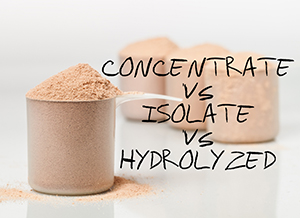Get instant access to cutting edge Nutrition, Fitness and Health tips and YES even Healthy Recipes.

Protein is so incredibly important when it come to our bodies. In fact, except for water, protein is the most abundant substance used by the body. And while more advanced nutrition studies are now showing a compelling advantage of higher protein diets being linked to better overall body composition and metabolic health, many of us are still well below an optimal amount needed to support this. Although there is a fairly wide spectrum of opinions when it comes to just how much protein we actually need, a majority of the recommendations are far too low. (1)
Protein, being the main building block of the body is found in every cell. And because our body is in a constant state of flux, continually breaking down and rebuilding its own tissues, we need to consume enough protein every single day in order to aid in the process of making and repairing muscles, tendons, organs, and skin as well as enzymes, hormones, neurotransmitters, and body chemicals that serve important functions. (2)
In fact, protein is the hardest macronutrient for our bodies to disassemble and process. And being five times more metabolically demanding than both carbohydrates and fat makes it the most thermogenic macronutrient. What this means is that by simply putting more protein in your diet you will automatically raise your metabolism. This is a natural effect of increasing your protein intake. (3, 4)
While adding more protein to your diet can be greatly advantageous, many of us are so pressed for time we find it nearly impossible to eat enough of this highly needed nutrient. Juggling kids, work, appointments and all the other curveballs life throws our way makes that omelet for breakfast, chicken salad for lunch and steak for dinner sometimes seem literally unmanageable.
In those instances, a good protein powder supplement can come in handy to pick up the slack. Mixing a protein shake is a fast, convenient way to add 25 to 50 grams of quality protein to your daily intake. This can be important for gym enthusiasts, people who are on a weight loss journey, or anyone simply lacking adequate protein in their diet.
Protein powders are concentrated sources of protein derived from animal or plant sources such as dairy, eggs, rice, peas or seeds.
There are typically three common classifications that all protein powder will fall under:
These protein powders are produced by extracting the protein from their whole food source using heat and acid or enzymes. They typically contain between 60–80 percent protein, with the remaining 20–40 percent of its calories coming from fat and carbohydrates. (5)
This type of protein powder goes through an additional filtering step which removes a greater percentage of fat and carbohydrates, leaving behind a higher concentration of pure protein. Isolate powders typically contain between 90–95 percent protein, giving you more pure protein per equivalent dose compared to a concentrate. (6)
Hydrolysate is produced by further heating the product with acid or enzymes, which further breaks the bonds between the adjoined amino acids, making them pre-digested. This allows your body to be able to transport and absorb them more quickly, and your muscles utilize them up more easily. However, there are a few drawbacks to this extra process. First, it compromises taste, making it quite bitter. Second, this type of protein is quite expensive. Therefore, the extra cost in addition to its harsh taste, all for its rapid digestion rate, in my opinion, isn’t justifiable. (7)
Whey protein comes from milk. During the cheese making process, whey is the liquid that separates from the curds. It’s high in protein, but also contains lactose, a milk sugar that many people have difficulty digesting, which is commonly known as lactose intolerance.
Whey protein concentrate retains a significant portion of lactose during its processing. However, whey protein isolate, being additionally filtered, is stripped of nearly all of its lactose, making it acceptable to use for those who struggle with being lactose intolerant.
Whey is a quickly digested protein rich in branched-chain amino acids (BCAAs). And leucine, being one of these BCAAs, plays a major role in promoting muscle growth, repair and recovery. What this means is, when amino acids are digested and absorbed into the bloodstream, they are readily available for muscle protein synthesis (MPS), or the creation of new muscle tissue. (8, 9)
In fact, several studies conducted with normal-weight, overweight and obese individuals concluded that whey protein actually improved over-all body composition by decreasing fat mass and increasing lean muscle tissue. (10, 11)
What’s more, whey protein has also been shown to reduce ones appetite as much as other forms of protein. (12, 13, 14)
Other studies suggest that whey protein also has some anti-inflammatory properties, improve certain heart health markers in overweight and obese people. (15, 16)
Like whey, casein is a protein found in milk. However, casein is digested and absorbed much more slowly. Casein forms a gel when it interacts with stomach acid, slowing down stomach emptying and delaying the absorption of amino acids into the bloodstream. This results in a more gradual exposure of amino acids to the muscles, reducing the rate of muscle protein production. (17)
Based on those facts and other such studies, casein appears to be more effective than plant based proteins — but not as effective as whey protein — at increasing muscle protein synthesis and strength. (18, 19, 20)
Eggs are well known for being an exceptional source of high-quality complete protein. In fact, of all whole food sources, eggs have the highest Protein digestibility-corrected amino acid score (PDCAAS), which is a measure of a protein’s quality and how easily it is digested. (21, 22)
In addition, eggs, being highly satiating, are also one of the best foods for decreasing appetite and helping you stay full for hours. (23, 24)
However, egg protein powders are typically made from just the egg whites rather than whole eggs. And although the protein quality remains excellent, feelings of fullness are reduced considerably when yolks are removed.
Like all animal products, eggs are a complete protein source. That means they provide all of the essential amino acids your body can’t make by itself internally. What’s more, egg protein is second only to whey protein as the highest source of leucine, the BCAA that plays the biggest role in muscle health. (25)
But, unfortunately, egg white protein hasn’t been studied nearly as much as whey or casein. Therefore, although egg white protein could be a good choice for people with allergies to milk protein who prefer a supplement that’s based on animal protein whey and casein seem to be the better choice
Protein powders made from brown rice have been around for some time, but they have generally been considered inferior to whey protein for muscle building. Although rice protein contains all of the essential amino acids, it is just too low in lysine to be considered a complete protein, meaning all the essential amino acids in the right ratio for optimal body replenishment.
There isn’t a lot of research on rice protein powder, but one study compared the effects of rice and whey protein powders in fit young males. The 8-week study found that taking 48 grams of rice protein or whey protein daily resulted in similar changes in body composition, muscle strength and recovery. (26)
However, more research is required to determine whether brown rice protein would provide the same benefits as whey over the long term or in other populations as in obese, overweight people or the general population.
Some protein powders contain a blend of plant sources to provide complete protein with all the essential amino acids. These mixed plant protein powders typically contain a combination of two or more of the following proteins:
Plant proteins tend to be digested more slowly than animal proteins, due in part to their high fiber content. Although this may not be a problem for many people, it can limit the amount of amino acids available for immediate absorption. And, although inferior to an animal product protein powder, this may be a good choice for vegans or vegetarians.
When looking at the various options, although Concentrate protein powders are the cheapest alternative and Hydrolysate is the easiest for the body to metabolize, my personal recommendation for the general population is to use an isolate protein powder. It has a very high concentration of pure protein, high bioavailability, smooth taste, mid-tier price and couples well with any weight loss program. Also, whey isolate is functional for those struggling with lactose intolerance.

Get instant access to cutting edge Nutrition, Fitness and Health tips and YES even Healthy Recipes.
